
How to Invest in a Solar Farm: A Wise Renewable Energy Investment
Investing in a solar farm can be a profitable and environmentally conscious venture. With the increasing demand for renewable energy, solar farms have emerged as a lucrative investment opportunity. In this article, I’ll provide you with valuable insights on how to invest in a solar farm and maximize your returns.
Firstly, it’s crucial to conduct thorough research and due diligence before making any investment decisions. Familiarize yourself with the key aspects of solar energy, such as the technology involved, government incentives, and market trends. Understanding these factors will help you assess the potential profitability of a solar farm project.
How To Invest In A Solar Farm
Investing in a solar farm can be a lucrative opportunity for individuals looking to diversify their portfolio and support renewable energy. To make informed investment decisions, it’s important to understand the basics of solar farm investments. In this section, we’ll explore key considerations such as evaluating the potential return on investment, understanding the risks involved, and exploring government incentives.
Evaluating The Potential Return on Investment
When investing in a solar farm, one of the primary factors to consider is the potential return on investment (ROI). The ROI is influenced by various factors including location, size of the solar farm, efficiency of solar panels used, maintenance costs, and power purchase agreements (PPAs).
To assess ROI, investors often analyze metrics like internal rate of return (IRR), cash flow projections, and payback period. These metrics help determine how long it will take to recoup the initial investment and start generating profits. Conducting thorough financial analysis with reliable data can provide valuable insights into whether a specific solar farm investment is likely to deliver satisfactory returns.
Understanding The Risks Involved
Like any investment opportunity, investing in solar farms carries certain risks that should not be overlooked. It’s crucial to understand these risks before committing capital.
- Market Uncertainty: Changes in government policies or regulations related to renewable energy can impact the profitability of solar farms.
- Technological Advancements: Rapid advancements in technology could lead to more efficient or cost-effective alternatives that may render existing solar farms less competitive.
- Weather Variability: Solar power generation relies heavily on sunlight availability; adverse weather conditions like prolonged cloud cover or heavy snowfall can affect energy production.
- Operational Challenges: Maintenance issues or unexpected equipment failures can result in downtime and reduced revenue generation.

Choosing The Right Location For Your Solar Farm Investment
When it comes to investing in a solar farm, one of the most crucial factors to consider is choosing the right location. The success and profitability of your investment largely depend on this decision. Here are some key points to keep in mind when selecting a location for your solar farm:
- Solar Resource Potential: It’s essential to assess the solar resource potential of different regions or sites before making a final decision. Look for areas with high levels of sunlight throughout the year, as this will ensure maximum energy generation from your solar panels.
- Land Availability: Adequate land availability is another critical factor to consider. Solar farms require large expanses of flat or gently sloping land to accommodate the installation of multiple solar panels. Conduct thorough research and explore areas that offer sufficient space for your project.
- Proximity to Transmission Infrastructure: Connection to existing transmission infrastructure is vital for efficient power distribution and access to electricity markets. Choosing a location near transmission lines can minimize costs and streamline the process of getting your solar farm connected to the grid.
- Regulatory Environment: Familiarize yourself with local regulations and policies regarding solar energy projects in prospective locations. Some regions may have more favorable incentives, tax credits, or streamlined permitting processes that can significantly impact the financial viability of your investment.
- Environmental Considerations: Ensure that you conduct an environmental assessment before finalizing any site for your solar farm investment. Evaluate factors such as nearby protected areas, wildlife habitats, water sources, and any potential ecological impacts associated with construction and operation.
- Economic Factors: Consider economic factors such as property prices, labor costs, local tax rates, and proximity to potential consumers or off-takers who might purchase the generated electricity from your solar farm.
Making an informed decision about where to invest in a solar farm involves careful evaluation of these factors while keeping in mind your specific goals and budget constraints.
By carefully considering the solar resource potential, land availability, transmission infrastructure, regulatory environment, environmental considerations, and economic factors of different locations, you can increase the chances of a successful and profitable solar farm investment.





